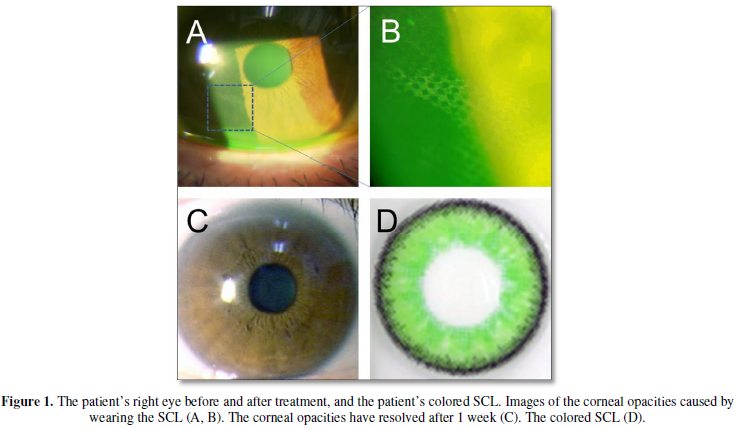2627
Views & Citations1627
Likes & Shares
INTRODUCTION
Colored
contact lenses are used to change the appearance of the eyes and are very
popular. Some colored contact lenses have a series of tiny colored dots printed
on the lenses. Although this is not necessarily problematic, incorrect use of
colored contact lenses may cause ocular damage [1, 2]. We report a patient with
multiple corneal opacities after wearing colored contact lenses.
CASE REPORT
A 38-year-old man has used plain 2-weekly disposable soft contact
lenses (SCLs) for 15 years. He subsequently changed to green-colored monthly
disposable SCLs. One day, after he had been wearing the colored SCLs for about
12 hours, he noticed a burning sensation and blurred vision in both eyes.
Therefore, he stopped wearing the colored SCLs. Blurred vision of the left eye
improved within 1day, but blurred vision and irritation of the right eye
persisted. He presented to our hospital three days after he had stopped wearing
the colored SCLs. On examination, the best-corrected visual acuity was 20/40
for the right eye and 20/20 for the left eye. The right eye had green
superficial corneal opacities forming a honeycomb reticular pattern (Figure 1A, B). The patient was treated
by instillation of balanced salt solution eye drops every three hours. After
one week, his symptoms subsided and there was complete resolution of the
corneal opacities (Figure 1C).
Visual acuity was 20/20 for both eyes.
Colored SCLs are also called ‘decorative’, ‘costume’, or ‘fashion’ SCLs. Our patient purchased his colored SCLs cheaply on the internet (Figure 1D). Various low-cost colored SCLs, including poor quality lenses, can be obtained easily on the internet. Some of these SCLs have patterns printed on the lenses with water-soluble dyes. Sale of colored SCLs should be strictly controlled by legal regulations.
ACKNOWLEDGEMENT
Declared none.
CONFLICT OF INTEREST
Declared none.
PROPRIETARY INTEREST
The authors do not have any proprietary interest in this manuscript.
GRANTS AND FUNDS
This work was supported in part by a Grant-in-Aid for Scientific
Research from the Ministry of Education, Culture, Sports, Science.
QUICK LINKS
- SUBMIT MANUSCRIPT
- RECOMMEND THE JOURNAL
-
SUBSCRIBE FOR ALERTS
RELATED JOURNALS
- Oncology Clinics and Research (ISSN: 2643-055X)
- Journal of Alcoholism Clinical Research
- Journal of Forensic Research and Criminal Investigation (ISSN: 2640-0846)
- International Journal of AIDS (ISSN: 2644-3023)
- Journal of Renal Transplantation Science (ISSN:2640-0847)
- Journal of Immunology Research and Therapy (ISSN:2472-727X)
- Journal of Cell Signaling & Damage-Associated Molecular Patterns


